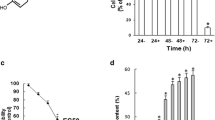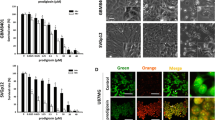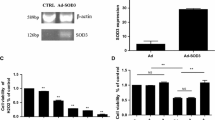Abstract
Malignant (N-type) neuroblastoma continues to defy current chemotherapeutic regimens. We tested the garlic compounds diallyl sulfide (DAS) and diallyl disulfide (DADS) for induction of apoptosis in human malignant neuroblastoma SH-SY5Y cells. Viability of human primary neurons was unaffected after 24 h treatment with 50 and 100 μM DAS and 50 μM DADS but slightly affected with 100 μM DADS. Treatment with 50 and 100 μM DAS or DADS significantly decreased viability in SH-SY5Y cells. Wright staining showed morphological features of apoptosis in SH-SY5Y cells treated with 50 and 100 μM DAS or DADS for 24 h. ApopTag assay demonstrated DNA fragmentation in apoptotic cells. Apoptosis was associated with an increase in [Ca2+]i, increase in Bax:Bcl-2 ratio, mitochondrial release of cytochrome c, increase in cytosolic Smac/Diablo, and down regulation of inhibitor-of-apoptosis proteins and nuclear factor kappa B (NFκB). Activation of caspase-9 and caspase-3 indicated involvement of intrinsic pathway of apoptosis. Calpain and caspase-3 activities produced 145 kD spectrin break down product (SBDP) and 120 kD SBDP, respectively. Also, caspase-3 activity cleaved inhibitor of caspase-activated DNase (ICAD). Results strongly suggested that the garlic compounds DAS and DADS suppressed anti-apoptotic factors and activated calpain and intrinsic caspase cascade for apoptosis in SH-SY5Y cells.









Similar content being viewed by others
Abbreviations
- BIRC-2::
-
Baculovirus inhibitor-of-apoptosis repeat containing-2
- BIRC-3::
-
Baculovirus inhibitor-of-apoptosis repeat containing-3
- [Ca2+]i::
-
Intracellular free calcium concentration
- CAD::
-
Caspase-activated DNase
- c-IAP1::
-
Cellular inhibitor-of-apoptosis protein 1
- c-IAP2::
-
Cellular inhibitor-of-apoptosis protein 2
- DADS::
-
Diallyl disulfide
- DAS::
-
Diallyl sulfide
- IAPs::
-
Inhibitor-of-apoptosis proteins
- ICAD::
-
Inhibitor of caspase-activated DNase
- IκВα::
-
Inhibitor of nuclear factor kappa B alpha
- NFκВ::
-
Nuclear factor kappa B
- SBDP::
-
Spectrin breakdown product
- Smac/Diablo::
-
Second mitochondrial activator of caspases/direct IAP binding protein with low pI
References
Brodeur GM (2003) Neuroblastoma: biological insights into a clinical enigma. Nat Rev Cancer 3(3):203–216
Irshad S, Pedley RB, Anderson J, Latchman DS, Budhram-Mahadeo V (2004) The Brn-3b transcription factor regulates the growth, behavior, and invasiveness of human neuroblastoma cells in vitro and in vivo. J Biol Chem 279(20):21617–21627
Maris JM, Matthay KK (1999) Molecular biology of neuroblastoma. J Clin Oncol 17(7):2264–2279
Kabore AF, Johnston JB, Gibson SB (2004) Changes in the apoptotic and survival signaling in cancer cells and their potential therapeutic implications. Curr Cancer Drug Targ 4(2):147–163
Kim R (2005) Recent advances in understanding the cell death pathways activated by anticancer therapy. Cancer 103(8):1551–1560
Orrenius S (2004) Mitochondrial regulation of apoptotic cell death. Toxicol Lett 149(1–3):19–23
Kroemer G, Reed JC (2000) Mitochondrial control of cell death. Nat Med 6(5):513–519
Goyal L (2001) Cell death inhibition: keeping caspases in check. Cell 104(6):805–808
Moore JD, Rothwell NJ, Gibson RM (2002) Involvement of caspases and calpains in cerebrocortical neuronal cell death is stimulus-dependent. Br J Pharmacol 135(4):1069–1077
Sakahira H, Enari M, Nagata S (1998) Cleavage of CAD inhibitor in CAD activation and DNA degradation during apoptosis. Nature 391(6662):96–99
Deveraux QL, Reed JC (1999) IAP family proteins—suppressors of apoptosis. Genes Dev 13(3):239–252
Kasof GM, Gomes BC (2001) Livin, a novel inhibitor of apoptosis protein family member. J Biol Chem 276(6):3238–3246
Mitsiades N, Mitsiades CS, Poulaki V et al (2002) Biologic sequelae of nuclear factor-kappaB blockade in multiple myeloma: therapeutic applications. Blood 99(11):4079–4086
Notarbartolo M, Poma P, Perri D, Dusonchet L, Cervello M, D’Alessandro N (2005) Antitumor effects of curcumin, alone or in combination with cisplatin or doxorubicin, on human hepatic cancer cells. Analysis of their possible relationship to changes in NFκB activation levels and in IAP gene expression. Cancer Lett 224(1):53–65
Zou T, Rao JN, Guo X et al (2004) NFκB-mediated IAP expression induces resistance of intestinal epithelial cells to apoptosis after polyamine depletion. Am J Physiol Cell Physiol 286(5):C1009–C1018
Takano J, Tomioka M, Tsubuki S et al (2005) Calpain mediates excitotoxic DNA fragmentation via mitochondrial pathways in adult brains: evidence from calpastatin mutant mice. J Biol Chem 280(16):16175–16184
Nicotera P, Orrenius S (1998) The role of calcium in apoptosis. Cell Calcium 23(2–3):173–180
Sharma AK, Rohrer B (2004) Calcium-induced calpain mediates apoptosis via caspase-3 in a mouse photoreceptor cell line. J Biol Chem 279(34):35564–35572
Chan SL, Mattson MP (1999) Caspase and calpain substrates: roles in synaptic plasticity and cell death. J Neurosci Res 58(1):167–190
Wang KK (2000) Calpain and caspase: can you tell the difference? Trends Neurosci 23(1):20–26
Ray SK, Fidan M, Nowak MW, Wilford GG, Hogan EL, Banik NL (2000) Oxidative stress and Ca2+ influx upregulate calpain and induce apoptosis in PC12 cells. Brain Res 852(2):326–334
Gao G, Dou QP (2000) N-terminal cleavage of bax by calpain generates a potent proapoptotic 18-kDa fragment that promotes bcl-2-independent cytochrome c release and apoptotic cell death. J Cell Biochem 80(1):53–72
Altznauer F, Conus S, Cavalli A, Folkers G, Simon HU (2004) Calpain-1 regulates Bax and subsequent Smac-dependent caspase-3 activation in neutrophil apoptosis. J Biol Chem 279(7):5947–5957
Neumar RW, Xu YA, Gada H, Guttmann RP, Siman R (2003) Cross-talk between calpain and caspase proteolytic systems during neuronal apoptosis. J Biol Chem 278(16):14162–14167
Nath R, Raser KJ, Stafford D et al (1996) Non-erythroid a-spectrin breakdown by calpain and interleukin 1b-converting-enzyme-like protease(s) in apoptotic cells: contributory roles of both protease families in neuronal apoptosis. Biochem J 319(Pt 3):683–690
Agarwal KC (1996) Therapeutic actions of garlic constituents. Med Res Rev 16(1):111–124
Takahashi S, Hakoi K, Yada H, Hirose M, Ito N, Fukushima S (1992) Enhancing effects of diallyl sulfide on hepatocarcinogenesis and inhibitory actions of the related diallyl disulfide on colon and renal carcinogenesis in rats. Carcinogenesis 13(9):1513–1518
Wargovich MJ, Imada O, Stephens LC (1992) Initiation and post-initiation chemopreventive effects of diallyl sulfide in esophageal carcinogenesis. Cancer Lett 64(1):39–42
Sparnins VL, Barany G, Wattenberg LW (1988) Effects of organosulfur compounds from garlic and onions on benzo[a]pyrene-induced neoplasia and glutathione S-transferase activity in the mouse. Carcinogenesis 9(1):131–134
Hayes MA, Rushmore TH, Goldberg MT (1987) Inhibition of hepatocarcinogenic responses to 1,2-dimethylhydrazine by diallyl sulfide, a component of garlic oil. Carcinogenesis 8(8):1155–1157
Suzui N, Sugie S, Rahman KM et al (1997) Inhibitory effects of diallyl disulfide or aspirin on 2-amino-1-methyl-6-phenylimidazo [4,5-b]pyridine-induced mammary carcinogenesis in rats. Jpn J Cancer Res 88(8):705–711
Arora A, Siddiqui IA, Shukla Y (2004) Modulation of p53 in 7,12-dimethylbenz[a]anthracene-induced skin tumors by diallyl sulfide in Swiss albino mice. Mol Cancer Ther 3(11):1459–1466
Nakagawa H, Tsuta K, Kiuchi K, et al (2001) Growth inhibitory effects of diallyl disulfide on human breast cancer cell lines. Carcinogenesis 22(6):891–897
Hong YS, Ham YA, Choi JH, Kim J (2000) Effects of allyl sulfur compounds and garlic extract on the expression of Bcl-2, Bax, and p53 in non-small cell lung cancer cell lines. Exp Mol Med 32(3):127–134
Xiao D, Choi S, Johnson DE et al (2004) Diallyl trisulfide-induced apoptosis in human prostate cancer cells involves c-Jun N-terminal kinase and extracellular-signal regulated kinase-mediated phosphorylation of Bcl-2. Oncogene 23(33):5594–6606
Herman-Antosiewicz A, Singh SV (2004) Signal transduction pathways leading to cell cycle arrest and apoptosis induction in cancer cells by Allium vegetable-derived organosulfur compounds: a review. Mutat Res 555(1–2):121–131
Biedler JL, Helson L, Spengler BA (1973) Morphology and growth, tumorigenicity, and cytogenetics of human neuroblastoma cells in continuous culture. Cancer Res 33(11):2643–2652
Ray SK, Wilford GG, Crosby CV, Hogan EL, Banik NL (1999) Diverse stimuli induce calpain overexpression and apoptosis in C6 glioma cells. Brain Res 829(1–2):18–27
Karmakar S, Weinberg MS, Banik NL, Patel SJ, Ray SK (2006) Activation of multiple molecular mechanisms for apoptosis in human malignant glioblastoma T98G and U87MG cells treated with sulforaphane. Neuroscience 141(3):1265–1280
Das A, Sribnick EA, Wingrave JM et al (2005) Calpain activation in apoptosis of ventral spinal cord 4.1 (VSC4.1) motoneurons exposed to glutamate: Calpain inhibition provides functional neuroprotection. J Neurosci Res 81(4):551–562
Grynkiewicz G, Poenie M, Tsien RY (1985) A new generation of Ca2+ indicators with greatly improved fluorescence properties. J Biol Chem 260(6):3440–3450
Jiang ST, Wang JH, Chang T, Chen CS (1997) A continuous method for measuring calpain activity. Anal Biochem 244(2):233–238
Ray SK, Karmakar S, Nowak MW, Banik NL (2006) Inhibition of calpain and caspase-3 prevented apoptosis and preserved electrophysiological properties of voltage-gated and ligand-gated ion channels in rat primary cortical neurons exposed to glutamate. Neuroscience 139(2):577–595
Karmakar S, Banik NL, Patel SJ, Ray SK (2006) Curcumin activated both receptor-mediated and mitochondria-mediated proteolytic pathways for apoptosis in human glioblastoma T98G cells. Neurosci Lett 407(1):53–58
Park EK, Kwon KB, Park KI, Park BH, Jhee EC (2002) Role of Ca2+ in diallyl disulfide-induced apoptotic cell death of HCT-15 cells. Exp Mol Med 34(3):250–257
Lin HL, Yang JS, Yang JH, et al (2006) The role of Ca2+ on the DADS-induced apoptosis in mouse-rat hybrid retina ganglion cells (N18). Neurochem Res 31(3):383–393
Sergeev IN (2004) Genistein induces Ca2+-mediated, calpain/caspase-12-dependent apoptosis in breast cancer cells. Biochem Biophys Res Commun 321(2):462–467
Scoltock AB, Bortner CD, St J, Bird G, Putney JW Jr, Cidlowski JA (2000) A selective requirement for elevated calcium in DNA degradation, but not early events in anti-Fas-induced apoptosis. J Biol Chem 275(39):30586–30596
Foyouzi-Youssefi R, Arnaudeau S, Borner C, et al (2000) Bcl-2 decreases the free Ca2+ concentration within the endoplasmic reticulum. Proc Natl Acad Sci USA 97(11):5723–5728
Vanden Abeele F, Skryma R, Shuba Y, et al (2002) Bcl-2-dependent modulation of Ca2+ homeostasis and store-operated channels in prostate cancer cells. Cancer Cell 1(2):169–179
Hajnoczky G, Davies E, Madesh M (2003) Calcium signaling and apoptosis. Biochem Biophys Res Commun 304(3):445–454
Sur P, Sribnick EA, Patel SJ, Ray SK, Banik NL (2005) Dexamethasone decreases temozolomide-induced apoptosis in human gliobastoma T98G cells. Glia 50(2):160–167
Farid P, Gomb SZ, Peter I, Szende B (2001) Bcl-2, p53 and bax in thyroid tumors and their relation to apoptosis. Neoplasma 48(4):299–301
Filomeni G, Aquilano K, Rotilio G, Ciriolo MR (2003) Reactive oxygen species-dependent c-Jun NH2-terminal kinase/c-Jun signaling cascade mediates neuroblastoma cell death induced by diallyl disulfide. Cancer Res 63(18):5940–5949
Koh SH, Kwon H, Park KH, et al (2005) Protective effect of diallyl disulfide on oxidative stress-injured neuronally differentiated PC12 cells. Mol Brain Res 133(2):176–186
Dai Z, Zhu WG, Morrison CD, et al (2003) A comprehensive search for DNA amplification in lung cancer identifies inhibitors of apoptosis cIAP1 and cIAP2 as candidate oncogenes. Hum Mol Genet 12(7):791–801
Verhagen AM, Ekert PG, Pakusch M, et al (2000) Identification of Diablo, a mammalian protein that promotes apoptosis by binding to and antagonizing IAP proteins. Cell 102(1):43–53
Wilkinson JC, Wilkinson AS, Scott FL, Csomos RA, Salvesen GS, Duckett CS (2004) Neutralization of Smac/Diablo by inhibitors of apoptosis (IAPs). A caspase-independent mechanism for apoptotic inhibition. J Biol Chem 279(49):51082–51090
Adrain C, Creagh EM, Martin SJ (2001) Apoptosis-associated release of Smac/Diablo from mitochondria requires active caspases and is blocked by Bcl-2. EMBO J 20(23):6627–6636
Hasenjager A, Gillissen B, Muller A, et al (2004) Smac induces cytochrome c release and apoptosis independently from Bax/Bcl-xL in a strictly caspase-3-dependent manner in human carcinoma cells. Oncogene 23(26):4523–4535
Beg AA, Baltimore D (1996) An essential role for NFκB in preventing TNF-α-induced cell death. Science 274(5288):782–784
Jeremias I, Kupatt C, Baumann B, Herr I, Wirth T, Debatin KM (1998) Inhibition of nuclear factor κB activation attenuates apoptosis resistance in lymphoid cells. Blood 91(12):4624–4631
Wang CY, Mayo MW, Korneluk RG, Goeddel DV, Baldwin AS Jr (1998) NFκB anti-apoptosis: induction of TRAF1 and TRAF2 and c-IAP1 and c-IAP2 to suppress caspase-8 activation. Science 281(5383):1680–1683
Lin MW, Tsao LT, Huang LJ, et al (2006) Inhibition of lipopolysaccharide-stimulated NO production by crotafuran B in RAW 264.7 macrophages involves the blockade of NFκB activation through the increase in IκBα synthesis. Toxicol Appl Pharmacol 210(1–2):108–115
Ide N, Lau BH (2001) Garlic compounds minimize intracellular oxidative stress and inhibit nuclear factor κB activation. J Nutr 131(3s):1020S–1026S
Keiss HP, Dirsch VM, Hartung T, et al (2003) Garlic (Allium sativum L.) modulates cytokine expression in lipopolysaccharide-activated human blood thereby inhibiting NFκB activity. J Nutr 133(7):2171–2175
Du C, Fang M, Li Y, Li L, Wang X (2000) Smac, a mitochondrial protein that promotes cytochrome c-dependent caspase activation by eliminating IAP inhibition. Cell 102(1):33–42
Kwon KB, Yoo SJ, Ryu DG, et al (2002) Induction of apoptosis by diallyl disulfide through activation of caspase-3 in human leukemia HL-60 cells. Biochem Pharmacol 63(1):41–47
Wang KK, Posmantur R, Nath R, et al (1998) Simultaneous degradation of αII- and βII-spectrin by caspase 3 (CPP32) in apoptotic cells. J Biol Chem 273(35):22490–22497
Acknowledgements
This investigation was supported in part by the R01 grants (CA-91460 and NS-57811) from the National Institutes of Health (Bethesda, MD, USA) and also by the Spinal Cord Injury Research Fund (SCIRF-0803) from the State of South Carolina.
Author information
Authors and Affiliations
Corresponding author
Rights and permissions
About this article
Cite this article
Karmakar, S., Banik, N.L., Patel, S.J. et al. Garlic compounds induced calpain and intrinsic caspase cascade for apoptosis in human malignant neuroblastoma SH-SY5Y cells. Apoptosis 12, 671–684 (2007). https://doi.org/10.1007/s10495-006-0024-x
Published:
Issue Date:
DOI: https://doi.org/10.1007/s10495-006-0024-x




